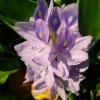Abstract
Waterhyacinth is one of the world’s worst aquatic weeds and is Florida’s most intensively managed floating plant. Dense mats formed by this species interfere with human uses of water bodies and disrupt ecosystems by preventing penetration of light and oxygen into the water column. This attractive, free-floating aquatic plant grows throughout the year in southern Florida but often dies back during the winter in the northern parts of the state. Waterhyacinth is cultivated as a water garden and pond plant, but cultivation, sale, and possession of this noxious weed is prohibited in Florida. This 5-page fact sheet was written by Lyn A. Gettys and published by the UF Department of Agronomy, September 2014.
SS-AGR-380/AG385: Waterhyacinth: Florida's Worst Floating Weed (ufl.edu)
References
Center, T. D., M. P. Hill, H. Cordo, and M. H. Julien. 2002. "Waterhyacinth." In Biological control of invasive plants in the eastern United States, edited by R. Van Driesche, B. Blossey, M. Hoddle, S. Lyon, and R. Reardon, 41-64. USDA Forest Service Publication FHTET-2002-04.
Cuda, J. 2014. "Chapter 9: insects for biocontrol of aquatic weeds." In Biology and control of aquatic plants: a best management practices handbook, 3rd ed., edited by L. A. Gettys, W. T. Haller, and D. G. Petty, 59-65. Marietta, GA: Aquatic Ecosystem Restoration Foundation. Online at http://aquatics.org/bmp.html (accessed 23 July 2014).
FDACS DPI. 2014 (access date). Florida Department of Agriculture and Consumer Services Division of Plant Industry Prohibited Aquatic Plants List. Online at https://www.flrules.org/gateway/RuleNo.asp?title=AQUATIC%20PLANT%20IMPORTATION,%20TRANSPORTATION,%20NON-NURSERY%20CULTIVATION,%20POSSESSION%20AND%20COLLECTION&ID=5B-64.011.
Flora of North America. 2014 (access date). "Flora of North America: Eichhornia crassipes." FNA26: 39-41. Online at http://www.efloras.org/florataxon.aspx?flora_id=1&taxon_id=200027394
Holm, L., J. Doll, E. Holm, J. Pancho, and J. Herberger. 1997. World weeds: natural histories and distribution. John Wiley, New York.
Klorer, J. 1909. "The water hyacinth problem." Journal of the Association of Engineering Societies 42: 33-48.
Langeland, K. A., and F. M. Fishel. 2010. SM-3 Aquatic Pest Control. Gainesville: University of Florida Institute of Food and Agricultural Sciences.
Lowe, S., M. Browne, S. Boudjelas, and M. De Poorter. 2000. 100 of the world's worst invasive alien species: a selection from the global invasive species database. The Invasive Species Specialist Group. Online at http://www.issg.org/pdf/publications/worst_100/english_100_worst.pdf (accessed 30 September 2014).
Mossler, M. A., and K. A. Langeland. 2013. Florida Crop/Pest Management Profile: Aquatic Weeds. Gainesville: University of Florida Institute of Food and Agricultural Sciences. http://edis.ifas.ufl.edu/pi175. https://doi.org/10.32473/edis-pi042-2013
Penfound, W. T., and T. T. Earle. 1948. "The biology of the water hyacinth." Ecological Monographs 18, no. 4: 447-472. http://www.jstor.org/stable/1948585 (accessed 23 July 2014). https://doi.org/10.2307/1948585
Tipping, P. W., T. D. Center, A. J. Sosa, and F. A. Dray, Jr. 2011. "Host specificity assessment and potential impact of Megamelus scutellaris (Hemiptera: Delphacidae) on waterhyacinth Eichhornia crassipes (Pontederiales: Pontederiaceae)." Biocontrol Science and Technology 21: 75-87. https://doi.org/10.1080/09583157.2010.525739
UF IFAS CAIP. 2014 (access date). "Plant management in Florida waters: an integrated approach." Online at http://plants.ifas.ufl.edu/manage/control-methods/details-about-the-aquatic-herbicides-used-in-florida
Webber, H. J. 1897. The water hyacinth, and its relation to navigation in Florida. US Department of Agriculture, Division of Botany, Bulletin No. 18. Washington, DC: US Government Printing Office. Online at http://ia600406.us.archive.org/9/items/waterhyacinthits00webb/waterhyacinthits00webb.pdf (accessed 23 July 2014).

